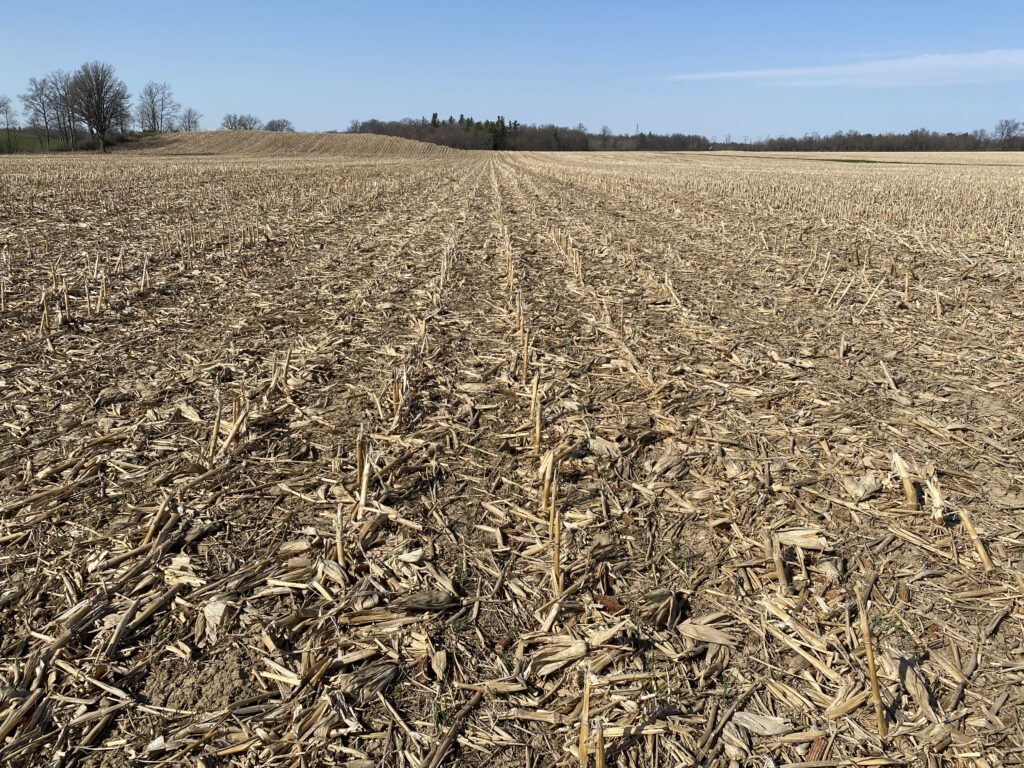Winter Wheat
Quite a bit of nitrogen was applied to winter wheat fields leading up to Sunday’s rain across both regions. Estimates are that 60-70% of total nitrogen (N) has been applied in the Chatham area, with 30-40% of N applied in Essex. In the Niagara/Haldimand area, 50% or more of the nitrogen has been applied. The most advanced wheat is estimated to be at Zadok’s growth stage 31 (first node detectable).
The wheat crop is highly variable. Good-looking wheat from the road may not look as good up close (e.g. tile-run wheat). Excess moisture in fall was a large contributor. It is important to lower yield expectations but still manage the crop to its full potential, especially considering higher prices.
Weeds in wheat are beginning to take off. Many fields, especially on heavier soils, were not sprayed last fall. Reports of Canada fleabane, chickweed and dandelion in wheat. Timely weed control is important. Dr. Peter Sikkema shared the best options, based on his research, for those weeds in wheat:
- Canada fleabane: Pixxaro M or Infinity. (Late fleabane emerging in fall has greater impact on yield than spring emerging fleabane).
- Chickweed: a herbicide with tribenuron (e.g. Refine or Boost)
- Dandelion: Infinity or Estaprop (though Estaprop can be hard on wheat in a stressed environment)
The OMAFRA Crop Protection Hub has information on herbicide options in wheat.
Plant Growth Regulators
It’s go time! Winter wheat fields have reached or will soon reach the optimal stage to apply plant growth regulators (PGRs). Manipulator and Moddus are labelled for application from growth stage 30 (stem elongation) to flag leaf (see wheat staging guide). When applied from GS 30-32, PGR’s have more effect on the lower stem, thus earlier applications give the best results. More PGR information can be found on Field Crop News.
Watch temperatures during application. Use the “rule of 3”: 3 days with night temperatures above 3° C. These conditions should be safe for most tank mix applications, including 3-way applications (PGR, herbicide, fungicide). If multiple products are added to the tank, the potential for phytotoxicity increases, especially under adverse weather conditions. If application is essential with poor weather, prioritize products included in the tank mix to avoid/reduce potential crop injury. Using higher water volumes (e.g., 20 gal/acre, 200 L/ha) is another critical management tool to reduce crop injury under questionable weather conditions. Always read and follow label directions.
Weed Control
Annual Ryegrass
There was discussion on best control options for annual ryegrass (ARG). Dr. Sikkema shared past research that showed a strong rate response of ARG to glyphosate. However, only 80% control was achieved at a rate of 1.33 L/ac. The addition of a Group 2 herbicide, in particular Rimsulfuron, as a tank mix partner to glyphosate increased control of ARG. Dr. Francois Tardif noted, however, that if 10-15% of plants survive, it may encourage resistance. He stressed the importance of having a plan for the plants that survive the herbicide application (e.g. rogueing).
Herbicide Resistant Waterhemp
Waterhemp populations resistant to group 27 herbicides (e.g. Callisto) have been confirmed in 7 Ontario Counties ranging from Essex in the south to Stormont, Dundas and Glengarry in the east by Hannah Symington (M.Sc. Candidate with Dr. Sikkema). More information on their findings can be found here. Identification and management tips can be found at: Waterhemp: Biology and Control or GFO: Agronomy Alert on Waterhemp.
Corn and Soybeans
Very minimal corn or soybean planting reported; limited to lighter soil textures. Some burndowns being done ahead of no-till soybean fields. Growers reminded to check seed germination and advised that this is not the year to reduce seeding rates.
It was noted by Dr. Sikkema that Sencor (metribuzin) antagonizes dicamba and that the two herbicides should not be mixed (e.g. for Xtend soybeans).
Horticultural Crops
Approximately 2,500 acres of sugar beets have been planted, which is one quarter of the anticipated total acreage. Early planted sugar beets are just emerging. Tillage and fertilizer application was occurring in the southwest for tomatoes. Planting may begin this coming weekend.
Declarations of Grain Eligibility
Beginning on July 1, 2022 in eastern Canada, declarations of grain eligibility will be required. Only grains subject to variety registration based on quality considerations will require a declaration. Corn and soybean are exempt. This change is being made by the Canadian Grain Commission after consultations with stakeholders. More information can be found on the Government of Canada webpage or on Real Agriculture.
Agricorp Update
For the Southwest Region, South Central Region and Niagara Region there were approximately 437 reports of damage this year to date for winter wheat, representing approximately 27,000 acres. Predominate perils were excessive rainfall and winterkill. The damaged acres as a percentage of total acres planted were approximately 27%.
- Deadline to apply or make changes for spring policy coverage for the 2022 spring crop year has been extended from May 1 to May 16, 2022.
- Wheat producers who were unable to insure their 2022 winter wheat by the planting deadline last fall can still secure winter wheat Production Insurance coverage without winter kill subject to an inspection before May 16.
- Please visit www.agricorp.com to obtain up to date information.
